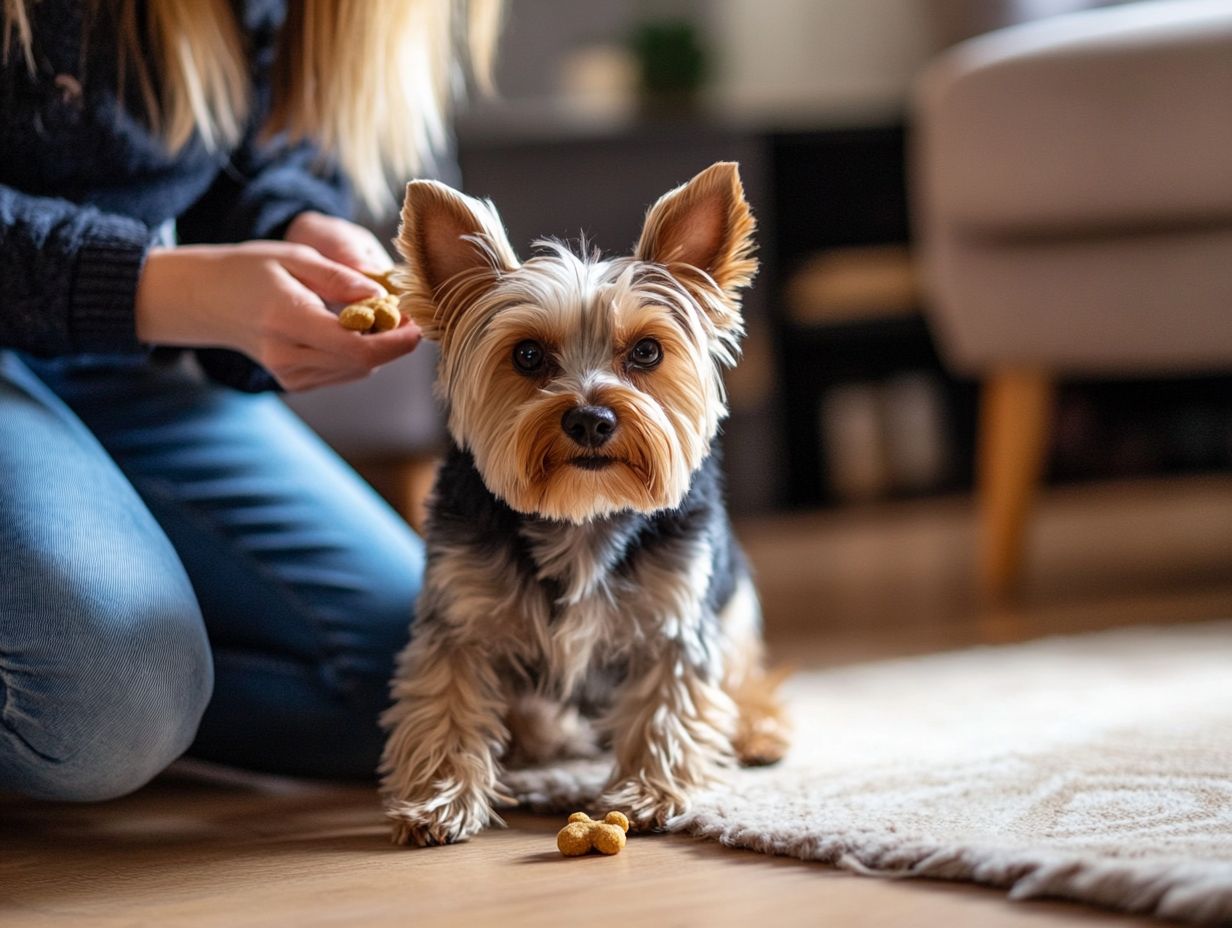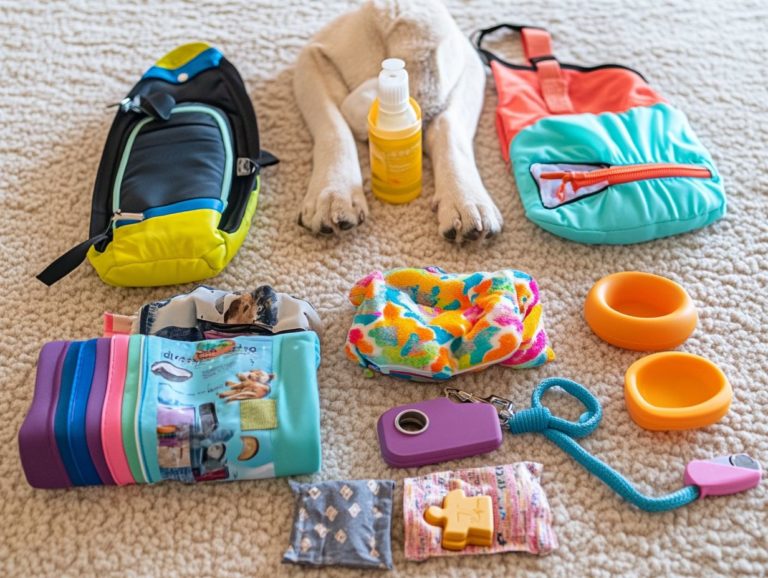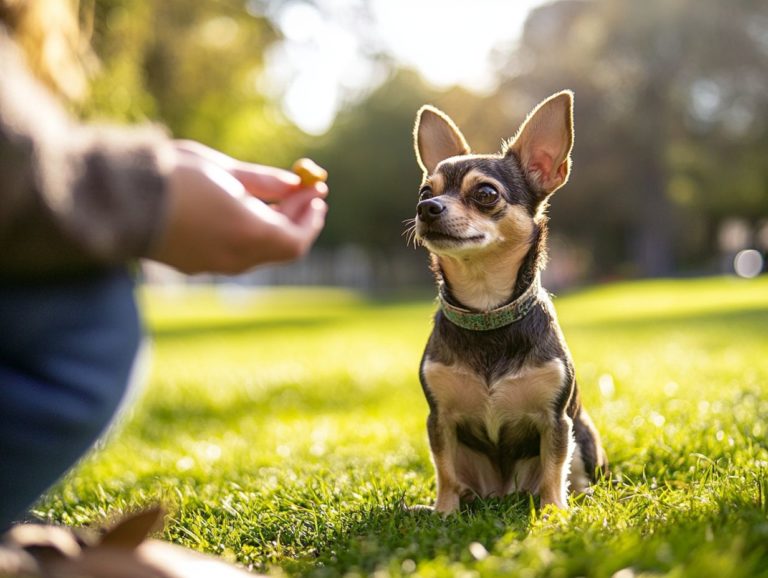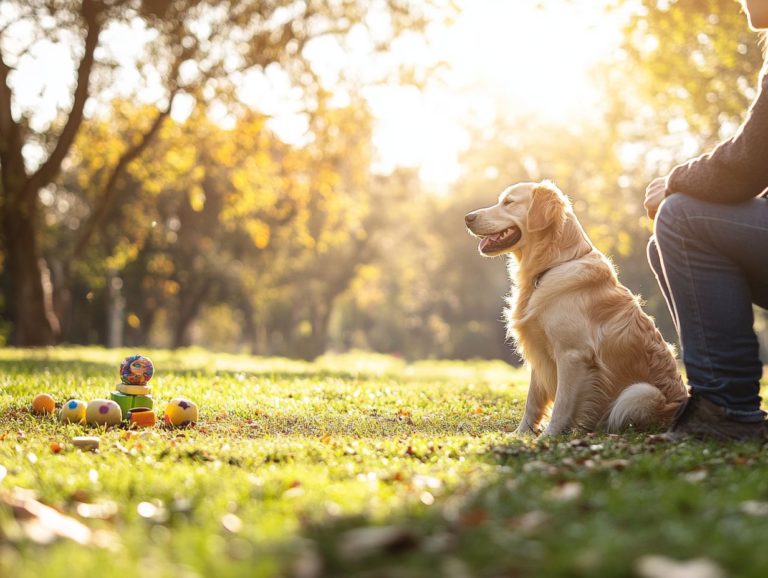Understanding Basic Commands for Anxious Pets
Training anxious pets is a game-changer. It gives them tools to feel secure and confident, and it also provides you with peace of mind. By investing time in training, you help them feel more secure, nurturing a deeper bond between you and your furry companion.
This article delves into fundamental commands such as “Sit,” “Stay,” “Come,” and “Leave It.” You’ll find invaluable tips for establishing a calm training environment. It also addresses how to effectively manage setbacks and identify things that make your pet anxious, empowering both you and your pet to navigate this journey with confidence and patience.
Contents
- Key Takeaways:
- Why Training is Important for Anxious Pets
- Common Commands for Anxious Pets
- Tips for Teaching Commands to Anxious Pets
- Dealing with Setbacks and Challenges
- Frequently Asked Questions
- What are some basic commands that can help calm an anxious pet?
- Why is it important to teach basic commands to anxious pets?
- Can basic commands help prevent anxiety in pets?
- How can I teach basic commands to an anxious pet?
- Are there any specific tips for teaching commands to an anxious pet?
- Are there any commands that should be avoided for anxious pets?
Key Takeaways:

- Training helps anxious pets feel secure.
- Teach commands like Sit, Stay, Come, and Leave It.
- Create a calm space for training and reward your pet.
Why Training is Important for Anxious Pets
Training is a game-changer for anxious pets. It equips them with the tools to develop calm behaviors, manage things that make them anxious, and cultivate a secure environment that promotes relaxation and positive associations.
Engaging in effective command training enhances your pet’s confidence, lowers excitement, and addresses any problematic behaviors that may arise from anxiety.
Structured training sessions benefit both you and your pet. They solidify your bond and create a happier environment.
Common Commands for Anxious Pets
Teaching common commands is crucial for anxious pets. It promotes impulse control, which is simply the ability to wait and not act immediately, and diminishes fear-based behaviors, creating a sense of calm in various environments.
Commands like ‘Sit’, ‘Stay’, ‘Come’, and ‘Leave It’ are fundamental in establishing a structured routine that provides reassurance for dogs during stressful moments.
Sit
The ‘Sit’ command is a foundational pillar in dog training, offering remarkable benefits, especially for managing anxious behaviors. It provides a moment of pause and relaxation, even amidst the chaos of daily life.
By teaching this command, you can effectively lower your pet’s excitement, fostering a sense of calmness. Begin by selecting a quiet space free from distractions, and keep your training sessions short yet frequent to maintain your dog’s focus.
Using treats to reward good behavior will encourage your furry companion to associate the command with pleasurable rewards. As your dog starts responding reliably to the command, you’ll establish a consistent routine, contributing to a more serene environment.
Over time, as your dog learns to relax on cue, you ll find that it can significantly alleviate anxiety during stressful situations, enhancing their overall well-being.
Stay
The command “Stay” is essential for encouraging your dog to maintain a position. This enables you to instill impulse control and promote relaxation, especially in anxiety-inducing situations.
This command not only helps manage your dog s behavior in distracting environments but also plays a crucial role in building a bond rooted in trust and security between you and your pet. When practiced consistently, “Stay” allows your dog to feel safe and reinforces a sense of stability as they learn to look to you for guidance.
Mastering “Stay” helps reduce anxiety triggers that could elevate stress levels for both you and your dog, creating a calmer atmosphere. By employing rewarding good behavior, you can effectively shape this behavior, ensuring your pet not only feels secure but also gains confidence in various scenarios.
Come

The ‘Come’ command is essential for creating a safe environment for anxious dogs. It helps them feel secure when responding to your call, even amid distractions.
This command is a practical tool for walks and outings. It also strengthens the bond between you and your pet.
Practice it consistently to foster positive associations that can reduce your dog s anxiety. Use high-value treats or engaging toys to motivate the desired response.
Start in calm settings. This approach helps your dog learn obedience and alleviates anxiety, allowing their instincts to shine when it matters most.
Leave It
The ‘Leave It’ command teaches your dog to ignore distractions and anxiety triggers. This helps your dog stay calm and enhances impulse control.
Nurturing this skill can minimize behavioral issues stemming from stress, such as excessive barking or destructive chewing. It redirects your dog’s focus from tempting yet problematic stimuli.
When practiced consistently, this command creates a safe and calming atmosphere for your dog.
Tips for Teaching Commands to Anxious Pets
Establish a serene environment to help anxious pets concentrate fully. This allows them to absorb training cues without feeling overwhelmed.
Creating a calm space significantly enhances their learning experience.
Creating a Calm Environment
A calm environment is essential for anxious pets. Minimize distractions and establish a safe space where your dog feels secure.
Incorporate familiar items, like soft toys or blankets, to provide comfort. Soft lighting and gentle music can also reduce stress levels.
Engaging in positive reinforcement makes training enjoyable. This will help alleviate any apprehension your pet may feel.
Positive Reinforcement Techniques
Positive reinforcement builds confidence and fosters positive associations with commands through rewards. This method creates a nurturing environment for sensitive animals.
Use small, easily digestible treats for motivation. Deliver rewards immediately after the desired behavior to strengthen the connection in your dog’s mind.
With patience and consistency, this positive association can help your anxious companion become a more confident and well-behaved pet.
Dealing with Setbacks and Challenges

Navigating setbacks and challenges during training is a familiar journey for dog owners, especially when working with anxious pets who grapple with behavioral issues and anxiety triggers. It s an experience that demands patience and understanding. Each hurdle presents an opportunity for growth both for you and your furry companion.
Understanding Triggers and How to Address Them
Understanding anxiety triggers is essential for you as a dog owner. It enables you to tackle specific fears and develop effective strategies for managing your pet’s behavioral challenges.
Recognizing these triggers starts with keen observation of your dog s reactions to various stimuli whether it’s loud noises, unfamiliar environments, or encounters with other animals. Pay attention to situations that spark distress, such as thunderstorms or crowded areas. This can help you uncover the root causes of your dog’s anxiety.
Once you’ve identified these triggers, you can implement gradual techniques to help your dog get used to their fears. This might involve exposing your dog to the trigger in a controlled, safe environment, rewarding calm behavior with treats or praise, and consistently fostering positive associations. With time and patience, these strategies can diminish anxiety responses and nurture a more relaxed demeanor in your beloved pet.
Seeking Professional Help if Needed
If anxiety issues linger despite your best training efforts, seeking professional help from veterinarians or dog behaviorists can be a game-changer. These experts offer invaluable guidance and tailored strategies for your anxious pet.
They possess a deep understanding of the complexities of canine behavior and can pinpoint any underlying medical conditions contributing to anxiety. This ensures a holistic treatment approach. Talk to your veterinarian about medication options that can work wonders alongside behavioral therapy! A dog behaviorist brings specialized training techniques that specifically target your pet’s anxiety triggers.
By collaborating, these professionals can help you craft a comprehensive training plan that incorporates anxiety-reducing strategies, effective desensitization methods, and reinforced positive behaviors. They will also assist in developing calm behaviors and impulse control techniques, which can help manage anxiety issues. Their joint expertise can lead to significant improvements in your dog s emotional well-being, providing you both with reassurance and a brighter future ahead.
Frequently Asked Questions
What are some basic commands that can help calm an anxious pet?
Some basic commands that can help calm an anxious pet include “sit,” “stay,” “down,” and “leave it.” Utilizing these calming commands, along with positive reinforcement for anxious pets, can redirect your pet’s attention and provide a sense of structure and control.
Why is it important to teach basic commands to anxious pets?

Teaching basic commands to anxious pets can improve their behaviors and overall well-being. These commands can provide a sense of security and confidence, helping to reduce anxiety and stress. For more insights, consider understanding the needs of anxious pets.
Can basic commands help prevent anxiety in pets?
While basic commands may not prevent anxiety in pets entirely, they can help manage and reduce symptoms. Consistently practicing these commands can strengthen the bond between you and your pet, and by utilizing obedience training to ease anxiety, you can help manage anxiety triggers through positive associations.
How can I teach basic commands to an anxious pet?
The key to teaching basic commands to an anxious pet is patience and positive reinforcement. Use treats and praise to reward your pet for following the commands. Additionally, understanding fear-based behaviors in pets can enhance your training efforts. Practice in a calm and quiet environment to help them feel more at ease.
Are there any specific tips for teaching commands to an anxious pet?
Yes, when teaching commands to an anxious pet, it’s important to keep training sessions short and frequent. This can prevent your pet from becoming overwhelmed and make the learning process more enjoyable for both of you, contributing to their overall well-being.
Are there any commands that should be avoided for anxious pets?
Certain commands like “come” and “stay” can make some pets anxious.
Evaluate what triggers your pet’s anxiety. Modify or avoid those commands as needed.
Help your furry friend feel at ease! If you’re unsure, talk to a trainer for tailored advice.






